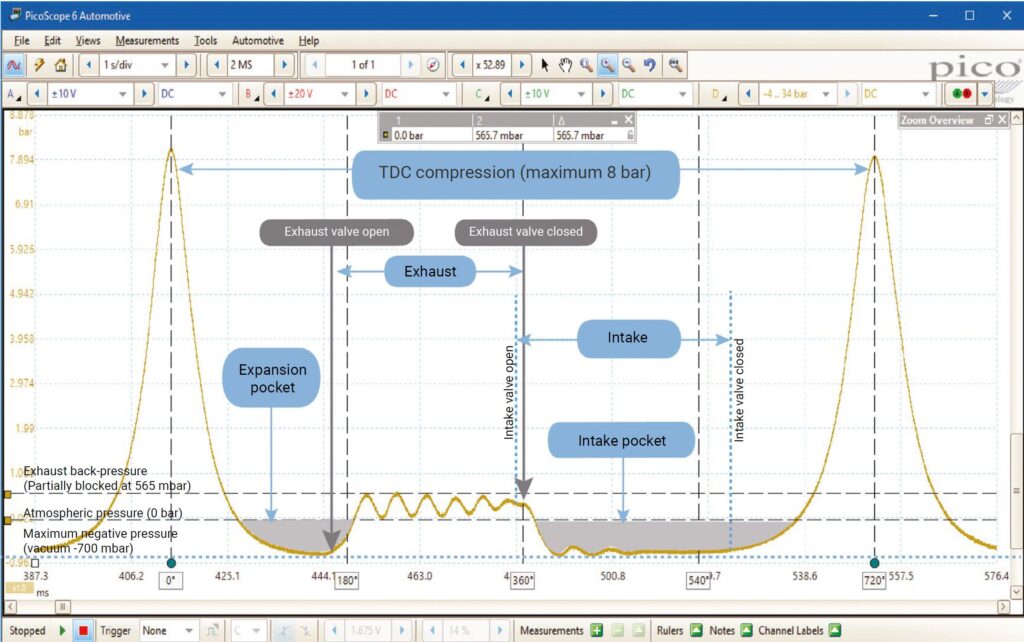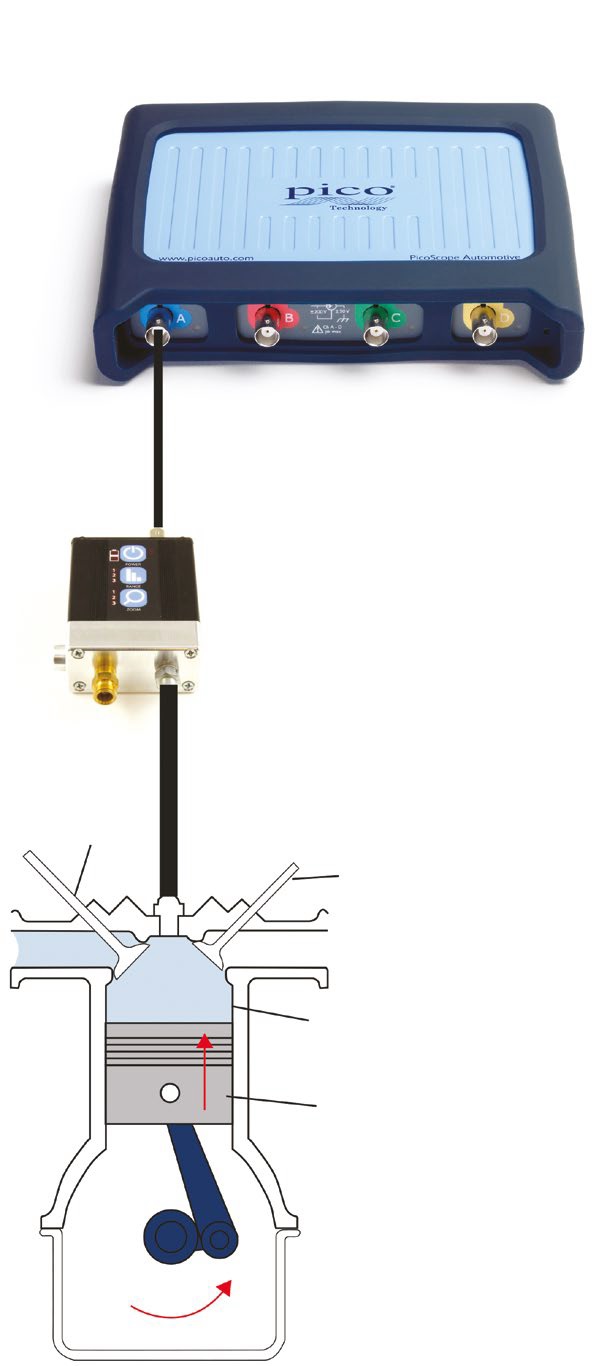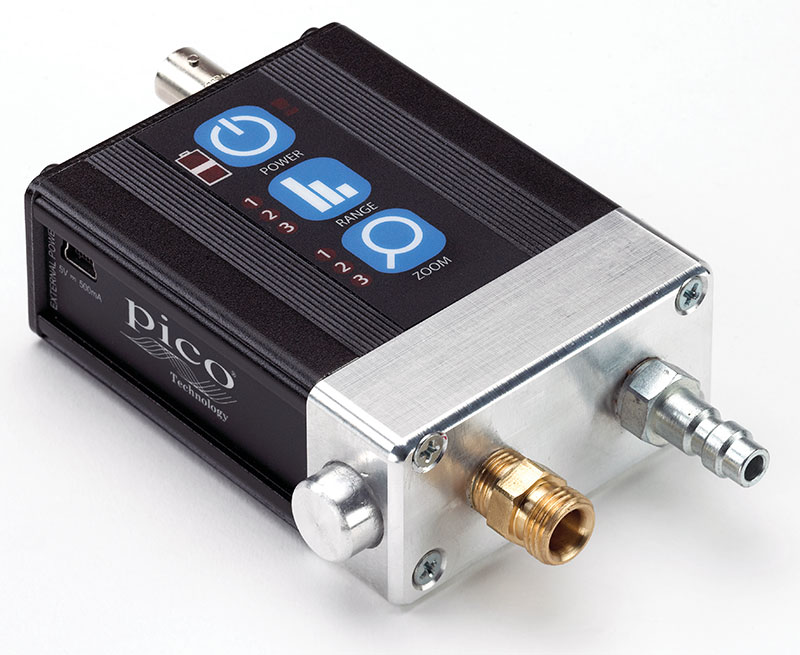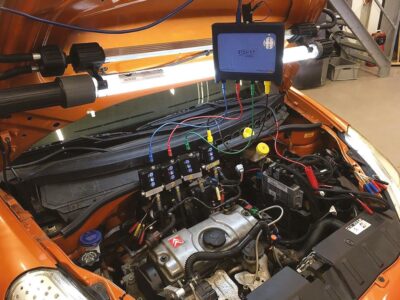Test 10 - WPS500X Cylinder Compression
A cylinder compression test using a compression guage only shows compression peaks because it uses a non-return valve. If, for instance, an exhaust valve fails to open, you will still see good compression. In this test we will use the WPS500X Pressure Sensor to graph the pressure of the cylinder whilst the engine is running.
- Software: PicoScope 6 - Guided Test AT157
- Purpose of Test - Petrol Engine Compression
- Skill Level Required - Intermediate
Connect: the WPS500X Pressure Transducer to PicoScope with the BNC to BNC test leads provided. Attach the transducer, as you would any compression gauge, by removing a spark plug and properly disabling the fuel system (if possible) and ignition for that cylinder.
Run: Start PicoScope and the engine. You may need to adjust the timebase and voltage scales to achieve the best signal display.
Read: Once you have captured your cylinder compression test waveform you will be able to see everything that is taking place in every 720° cycle of the engine.
To help you understand what you are seeing, use the rotation rulers (found in the bottom right-hand section of your PicoScope screen). You can adjust these markers to show 4 partitions, dividing the waveform into 180° sections and revealing the 4-stroke cycle. Now, with every stroke of the engine you can see exactly how the cylinder under test is operating, from peak to peak:
- Top Dead Centre (TDC)
- Cylinder moves down (Power Stroke)
- Exhaust Valve Opens
- Cylinder moves up (Exhaust Stroke)
- Exhaust Valve Closes whilst Inlet Valve Opens
- Cylinder Moves Down (Inlet Stroke)
- Inlet Valve Closes
- Cylinder moves up (Compression Stroke)
Switching the pressure transducer from one cylinder to the next is an easy way to have a direct and valuable comparison.

Waveform Analysis
The Expansion pocket should have the same depth as the Intake pocket. Anomalies here indicate errors with valve timing or valve seating issues.
The WPS500X Pressure Transducer
Our WPS500X pressure transducer is the essential add-on to your PicoScope kit, allowing you to accurately view vacuum and pressure levels up to 500 psi (34.5 bar). The ability to display pressure, alongside electrical component signals in real time, gives you an unparalleled view into engine and vehicle diagnostics.
Here is just one example of our WPS500X in use. With three different pressure ranges the WPS500X is optimized for measuring a vast array of vehicle pressures ranging from cylinder compression to positive and negative fuel line pressures and exhaust gas pulsations at the tailpipe (in relation to combustion).
Cylinder Compression Test Animation
Video Commentary
The video shows a problem with an exhaust valve which doesn't open properly. Stop the video (or look at the video overlay image when the page is loaded) and compare the position of the bad (left) and good (right) valves whilst the Cam lobe is pressing down.
Connect: Remove the spark plug and choose a spark plug compression adaptor that matches the length of the thread of the spark plug. If you use one that is too long, you risk mechanical damage. If you choose one that is too short then your compression ratio will be degraded.
Screw the adaptor onto the PICO-TA212 Compression Test Hose and then screw the adaptor into the cylinder in place of the spark plug.
Switch on your WPS500X before connecting the hose to it so that it can self-calibrate and choose range 1.
Connect the hose and then connect the WPS500X to channel A of your PicoScope.
Run: Start PicoScope and the engine. You may need to adjust the timebase and voltage scales to achieve the best signal display.
Read: The slow motion shows the position of the cylinder and the effect it has on the waveform in a good cylinder.
The problem with the valve that doesn't open properly is shown next. Notice the peak in pressure that results from compression during the exhaust stroke which is released when the inlet valve opens.
Now see our Free Pico Academy Course - a two and a half hour introductory course conducted by Pico in the UK for Garage Lube. Click here to continue.




